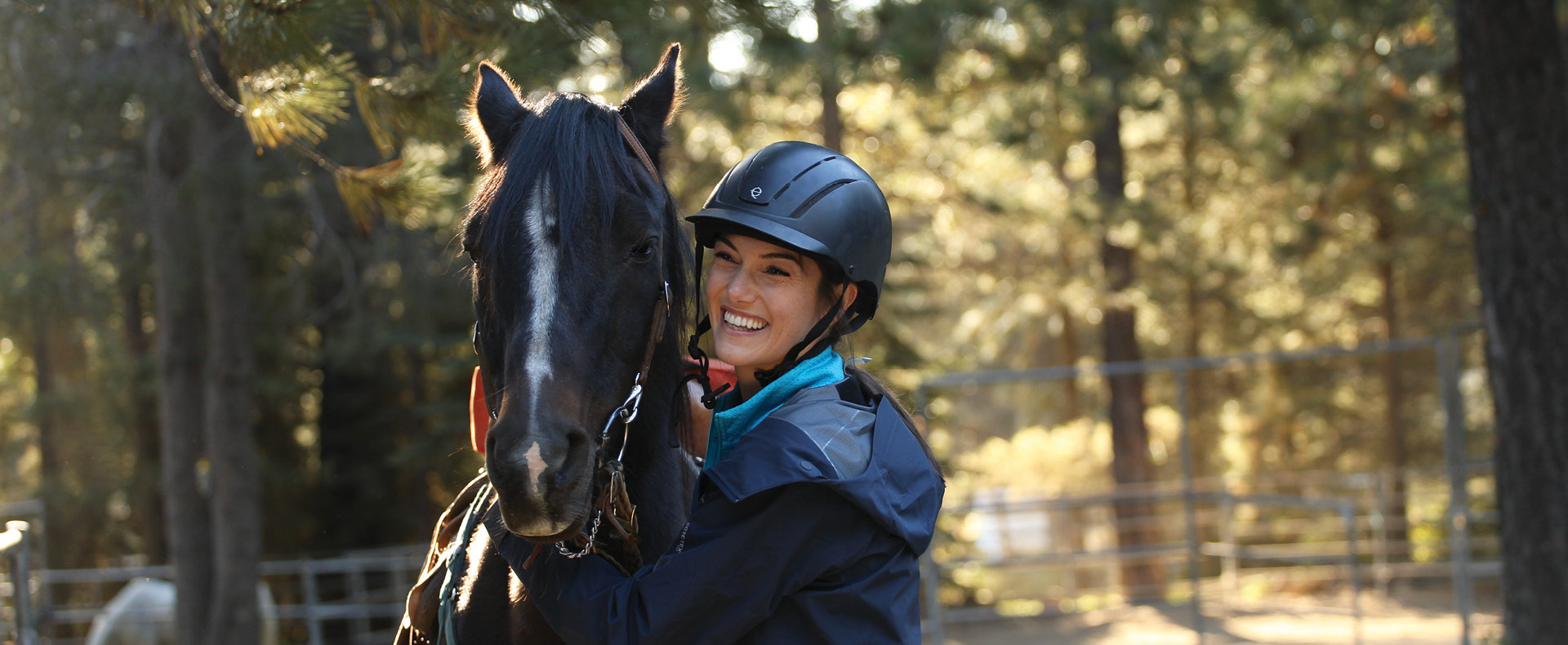
Harmony and Horses: How Horsemanship Expert Kansas Carradine Helps People Find Balance in Riding and Life
Association News, Member NewsIf you’ve ever had the privilege of riding a horse, you may have experienced a broad range of emotions, from joy and excitement to anxiety or fear. Horses are large animals with an average weight of roughly a thousand pounds. Compared to humans, horses exert an immense amount of strength and power. But as prey animals, their nature is much more complex, bearing incredible intelligence and intuition. For humans to have domesticated the equine species thousands of years ago was an extraordinary feat. Astonishingly, we are still learning so much about these animals today and, more importantly, our relationship with them.
Horsemanship expert Kansas Carradine has spent her entire lifetime around horses, and much of her knowledge of their behavior inherently comes from working day in and day out with these beautiful creatures. Whether priming horses on film sets or trick riding in the renowned live equestrian show Cavalia, she has developed an approach that fosters kinship and compassion. This approach also gave her the faculties to conquer the extraordinary Gaucho Derby, a 10-day, 500-kilometer horse race across the rugged Patagonian landscape in Chile.
For such a grueling race, Kansas contends there wasn’t much to the riding itself but relying solely on the extraordinary interspecies bond she established with seven different horses throughout the race. While her training isn’t necessarily geared toward such extreme circumstances, her approach has applications for all levels of riding and horse ownership and even for those who don’t ride. In sitting down with Kansas to chat about her philosophies and methods, it was a pleasure to discover just how practical and invaluable her training is.
FORCE OR FLOW
Last summer, my daughters and I leased a horse to be able to experience the joys of riding on our own time. We found a lovely paint mare who was gentle under saddle and affectionate with the girls. All went well in those first several weeks, but outside of the direction of her owner, she became increasingly sour. What started as an ideal situation began to devolve into a frustrating impasse. So, I decided the best thing to do was give up – the saddle.
Instead, I endeavored to take the opportunity to really understand and develop my horsemanship. For the next few weeks, we just spent time together. We walked on the lead, off the lead, around the arena or nowhere in particular. We got better acquainted, got comfortable in each other’s space and learned how to respect each other’s space. In the quiet, I discovered how much the pent-up frustration carried into our body language. A real breakthrough moment for us was a mutual release of this tension. Slowly, the real bonding began, and the riding got easier. This calm and collected mindset even carried over to my experiences with other horses.
Kansas referred to this phenomenon as “force or flow.” Forcing an interaction too much can often lead to vexing, harmful, or, in extreme cases, dangerous circumstances for horse and rider. As deeply intuitive herd animals, horses seek clarity in a direction setter but often mirror what their rider unconsciously communicates. Their instinct is to be somatically in tune with their companions. If a rider is anxious or disassociating, this can be unsettling or downright exasperating for all involved.
Flowing with horses means bringing awareness and presence to every interaction and establishing trust. This connection creates a container for growth for horse and rider, a place where communication, learning and bonding are optimal.




HORSEMANSHIP IS THE HEART OF THE EQUESTRIAN LIFESTYLE
For all my years of riding, even into my adult years, my horsemanship has been limited. It wasn’t a large part of my discipline, and as I learned from Kansas, that was true for much of the equestrian world. Mostly, we ride trained horses and muscle them through work or sport using groundwork, cues and aids, with far less consideration for their enrichment – or even our own.
As I delved into the world of horsemanship, I discovered that a more compassionate and horse-centered philosophy on training appeared to be a growing movement and something Kansas believes is a paradigm shift for the whole industry where a culture of dominance often prevails.
But what does enrichment look like? Most trainers and riders seek a sense of accomplishment with their horses only within the framework of the sport. However, a relationship that benefits both horse and rider honors the true nature of all horses, which is to be in cooperative alignment with their herd. In this more holistic approach, accomplishment could look like recognizing nonverbal cues from your horse, releasing tension, balancing your breath and heart rate with your horse before hopping in the saddle, or gently refining your communication to be more clear and effective. At other times, it may just be spending non-work time with your equine partner, bonding and playing and offering opportunities for positive and profound connection. These “small victories,” as it were, make the idea of horsemanship less daunting while supporting and nurturing growth and skills.
Riding is indeed one of the most unique and thrilling experiences, but if we think back on the moment we fell in love with the equestrian lifestyle, it really began with admiration for these majestic animals. Returning to the basics of awareness and connection and building a strong foundation with your horse or any horse is what heart-based horsemanship is about.
HEARTMATH® CLINICS ARE FOR EVERYONE
Like many challenges, the toughest horses usually have the most to teach us about ourselves. As mentioned, horses can elicit a broad range of emotions from humans. The HeartMath® approach teaches people how to bring awareness to their somatic tendencies when in the presence of a horse – acknowledging their heart frequencies, body language and feelings.
A heart-based approach to horsemanship enhances intuition and interoception and fosters positive dynamics between horses and humans. But it has applications far beyond the barn, including for people who don’t ride. HeartMath® techniques ultimately help humans self-regulate their emotions for enhanced coherence, compassion and poise, whether interacting with a horse, client or co-worker. Kansas encourages anyone interested in seeking or maintaining emotional balance to attend her upcoming clinic in Tahoe Donner.
For additional information and to register, visit circuscowgirl.com.


